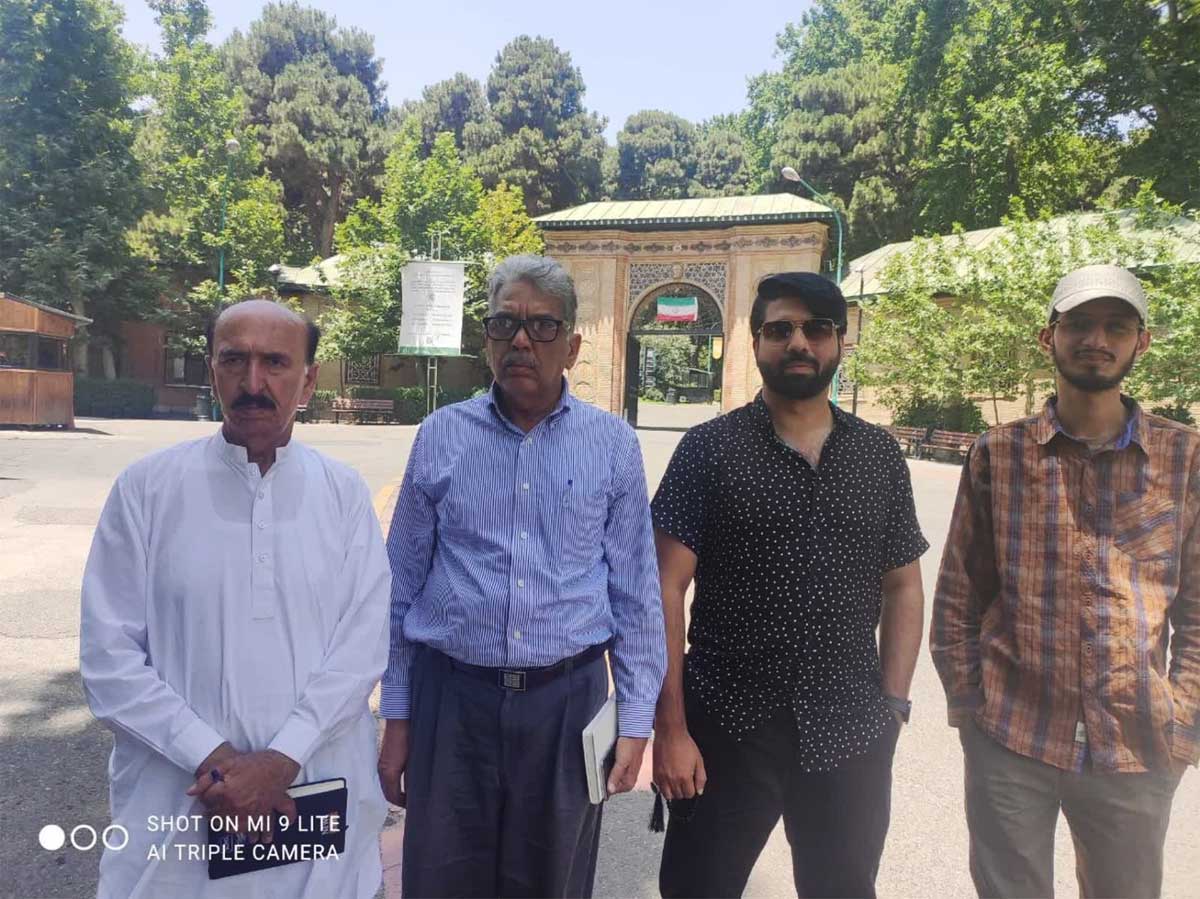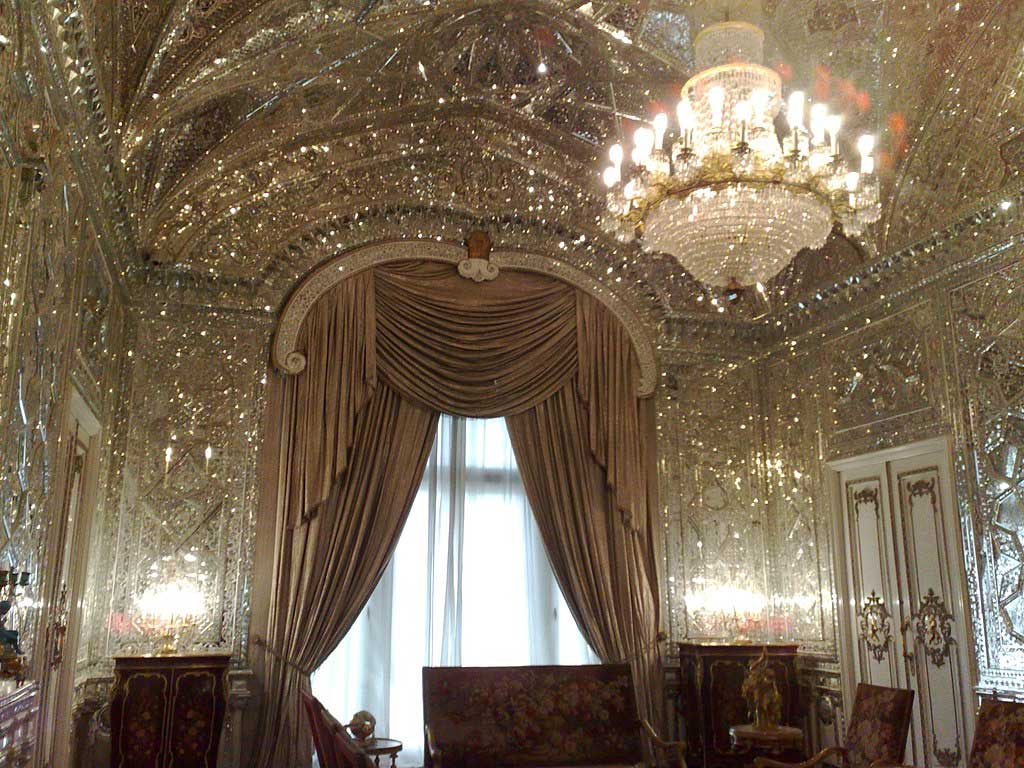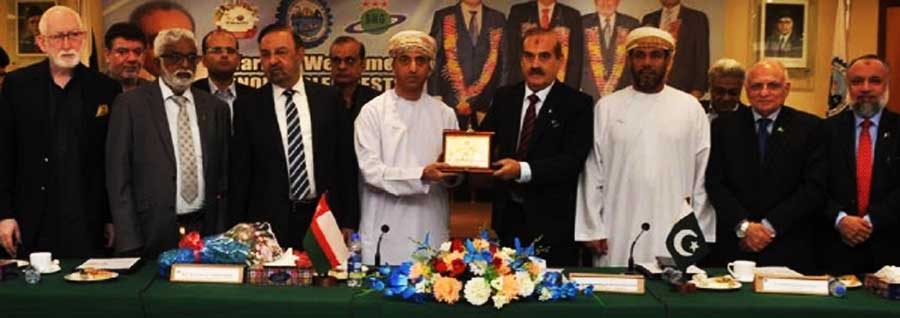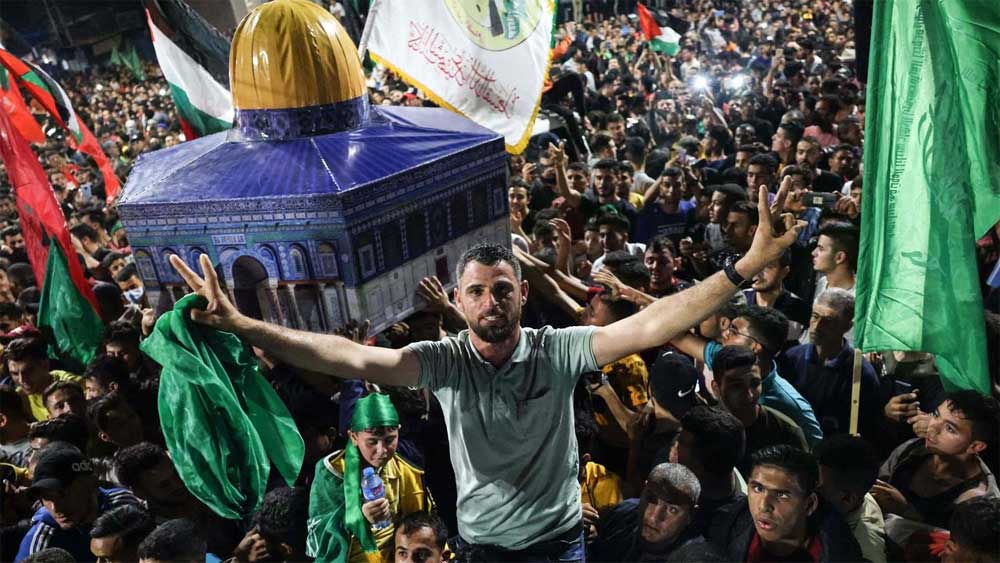
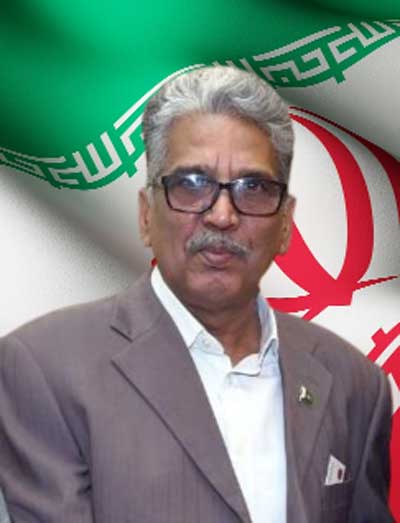
(Continued English translation of Mr Nazir Leghari’s Urdu write-ups). In front of the National Assembly, a legendary archer from Iranian folk tales stands, his statue towering high above the ground. Like the mythical hero, this archer was supposed to protect the National Assembly in a miraculous fashion. However, the palace, once inhabited, has now become a wonderland through the blows of revolution, with the archer still holding his bow defiantly.
In his quiver, alongside arrows, there is also a sword, but it’s merely for display among the trees’ banners, creating an intimidating sight. When the truth about the statue is revealed to the people, they become free from all fears. When the people of Iran faced the fear of tyrants and dagger-wielding, gun-bearing authoritarian rulers, and believed that they had chains and humiliating punishments waiting for them, the archers and dagger-wielding, gun-bearing warriors were trembling in their own fears.
We turn our backs to the archer statue and start ascending the stairs of the National Assembly. Ali Fatemi is walking alongside us. The palace has three floors. One floor is a refuge for the world-weary, where even the saved refugees cannot find solace when the time comes, and they can only offer refuge.
Among all the complexes in Saadabad, the National Assembly is the most beautiful palace. In its foundations, I can feel the scent of the blood of countless Iranians. I have not seen the red fort of the Mughals in Delhi; I have seen the Shahi Qila of my Lahore, where the cries of hundreds of political workers echo in the narrow streets of old Lahore during the last hours of the night. But here, the refuge is closed, then what is it? Here, in the daylight, the whispers and screams of the fearful Shahi dynasty of the night of January 15 and 16, 1979, are still audible. Just before the sunrise on January 16, these whispers and screams are coming out of the National Assembly towards Mehrabad Airport.
Freedom Tower resonates with the slogans of freedom. The royal family is heading towards the airport. A soldier runs towards the Shah at the airport and clings to his feet. Some say that the king is going to America for treatment, but what does America care, that it lifts the weary king from the people’s grip and offers refuge by playing cards with the Shah.
The Shah turns towards his eldest daughter Shahnaz Pahlavi, divorced wife of Theria, and his brother, former Shah Farouk, who is heading to his homeland, Egypt, where the Sudanese mother’s Abyssinian son, President Anwar Sadat, is seeking the favors of Queen Farah Diba, whom Shah has deserted. Hota hai, seeking her attention, in return for which Shah’s death is demanded.
We enter the National Assembly. I sketch an image of Shahi Sofas on one side. The royal guest room preserves my reflection in silence. Behind me, Manzar Naqvi is preserving a view of another room on the camera. The royal mirror preserves their image without telling them, without telling them their image from behind. There are beautiful carpets worth millions in this palace. The revolution feels like it is marching on the perspectives of these carpets. A woman here tells us about the various artifacts used on furniture, carpets, lanterns, and the gold and heroes in these rooms.
We see the shine of gold and silver things in the Shahi lounges and terraces. We are shown a royal wardrobe leading to the upper floor, where furniture has been placed, indicating that these ornaments can no longer be used. Perhaps the revolution has banned the use of these ornaments. On one side is a spacious drawing-room with a dozen sofa sets creating space for thirty people to sit. There is enough space for sixteen people to sit at the dining table in the dining room of the palace.
I am searching for the place in this palace where, in the final days of the Second World War, the heads of the Allied Superpowers, including American President Roosevelt, British Prime Minister Winston Churchill, and Soviet Communist Party Secretary General Joseph Stalin, held their last consultations. In this same place in Tehran, Roosevelt had hinted at the use of atomic bombs as a last resort to end the war, and in Roosevelt’s view, Stalin did not understand this hint. It is a separate matter that Stalin himself had come close to making an atomic bomb, which led to America initiating a global project for nuclear weapons according to its prepared plan, starting a global cold war.
On the Shahi terrace of the National Assembly, along with a wooden table, there is a golden telephone set, a golden hanger for dried fruit, a golden and diamond watch, and an ornamental frame with three pictures made of gold. In it are pictures of Reza Shah Pahlavi, Farah Diba, and former Crown Prince Reza.
Mellat Palace: Here, every room appears as a separate palace
Now, let’s take you through this royal palace. The rooms of this palace cannot simply be called rooms. Because when a room has a length of 96 meters for the children’s playpen, what space do we have to call it just a room? In the complex of palaces, there are separate places for the kitchen, utensils, and clothing, where two divorced queens, Soraya and Taj Al-Mulook, and the last queen Farah Diba, the sister of the king Ashraf Pahlavi, and daughters Shahnaaz, Farahnaz, and Leila have separate palaces for their clothing. What would be the condition of the palace where the king’s sister has her own library? I am emphasizing that every room in the Nation’s Palace looks like a separate palace. To reach the palace, you climb thirty-five stairs, and even these stairs exude the royal elegance and splendor.
When your gaze falls on the musical instruments placed in the palace, the sounds of Iranian musicians like Googoosh, Mohammad Reza Shajarian, Ebi, and Dariush Eghbali resonate in the air. The joy of the Nation’s Palace Art Complex leaves you astonished. There is a cinema hall in this palace, mostly located in the basement, which we couldn’t visit. The dressing room, security room, dining hall, billiard hall, and reception halls have their own distinct grandeur. The lower part of the aristocratic society’s curtain is a home where someone like me, an admirer of the palace, is observing the Nation’s Palace with fascination and narrating its stories. But I am sharing all this because I want you to be a part of my experience.
This palace, consisting of ten very large halls, was completed in 1931. The last king and his queen Farah Diba resided in this palace for years. The room where the affairs of the king’s rule come to fruition is very vast and spacious. It cannot be called just a room. In our homes, the middle-class people don’t have such a large area. The playpen in this room has a length of 76 feet. Besides the valuable furniture in this room, the noteworthy things here are the paintings tastefully hung on the walls. These masterpieces of Hispanic photographers, extracted through mosaics and brushes, are beyond comparison. Apart from the royal stairs for going up and down, there are separate stairs besides the royal adornments for going and coming from the first floor to the second floor. These are like the stairs in our homes, but in some way, they don’t seem like stairs going to another level. It seems that the height of two floors is covered by reaching here, and separate stairs are used for the return journey from the upper floor.

The queen and king’s golden chamber is also a very large hall. Whether you call this room a chamber or a palace, I leave that to you. In our North Nazimabad wedding halls, the area for the golden room is built just like a royal chamber. The area of this room is 770 square meters (920 square yards). There are stairs leading up to this room, distinct from the royal throne. The other rooms of the palace are not smaller than this royal dream space. The king’s office and dining room are connected to each other. In the dining hall, there are separate tables and chairs for breakfast, lunch, and dinner. Here, there is luxurious furniture and equipment. Everything has its own beauty. There is a unique style for arranging and using things.

The room for the king’s meetings is another large hall, where dozens of sofas and other luxurious items are present. I observe this room carefully and make assessments. On these sofas, Roosevelt, Stalin, and Churchill might have sat, and there, there would be seats for Winston Brandt and Pompidou. Field Marshal Ayub Khan may have had a meeting on these sofas. Zulfikar Ali Bhutto might have sat and conversed. Indira Gandhi would be sitting in that direction. Suleyman Demirel and Ismet Inonu might have had a conversation on these sofas. In the last phase of the meetings, even our Air Marshal (Asghar Khan) came here. It is said that the king, as a representative of American strategic interests in the region, had to decide about the rulers of our poor country after removing Bhutto from power. It is said that after the return of Asghar Khan, General Zia met Shah of Iran here in this very hall and asked, “What harm is there in me? Who can better guard American interests?”. They say at that time, everything was being heard, and laughter was echoing loudly.
In the room of these meetings, there is also a statue of Napoleon among the luxurious items. It has been listening to the words of every ruler from Roosevelt to Zia-ul-Haq. Many roles of the Battle of Waterloo, fought in the fields, are felt through the glimpses of history. Prince and Orange have been busy with Napoleon for many days so that the war and confrontation take place in his favorite Waterloo field, where Napoleon can be surrounded from three sides and brought to justice in the negotiations. With the help of the Wellington Parsi troops, the triumph holds its ground, and Napoleon, the unrivaled, according to Charles Shaw, is still considered an extremely biased view of Shaw’sism.
I am moving towards another hall where beautiful paintings of Iranian folk tales are displayed. Many characters from Ferdowsi’s Shahnameh are present on the walls for public viewing. I am looking for paintings of Zahhak and Kaveh the Blacksmith on the walls. Then suddenly, my unconsciousness reveals to me that this is the same Reza Shah Pahlavi. Ferdowsi wrote the story of Zahhak in Shahnameh, creating a timeless narrative of popular resistance. Ferdowsi tells that Zahhak is an ambitious prince with dreams of the throne and crown in his heart. Ferdowsi wrote the story of Zahhak, but this story is part of Iranian folk traditions and stories that were sung and heard in night gatherings even before Ferdowsi. In the Middle Ages of Persia, this story remained present in the texts and drafts of Avesta. In Zoroastrian stories, Zahhak is called Azi Dahaka. It is said that Zahhak was the son of Ahriman and the enemy of Ahura Mazda. Azi means serpent or snake in Arabic. One day, the devil persuades Zahhak that he can rule the throne by killing his father. Through this folk tale, the names Jamshid, Kaveh, Faridun, and Faranak are still present in Iran, which are placed at the birth of children.
When Zahhak has his father killed, two snakes emerge on both shoulders of him, which eat the brains of two young men every day. Now a proclamation is made in the city that people should write the names of their young children for the sacrifice of the king’s snakes. So, the chain of sacrifice of two young men daily begins for the food of the king’s snakes. One day, it is the turn of Kaveh the Blacksmith’s sons. Instead of taking his sons for sacrifice, Kaveh the Blacksmith goes to the market and, shouting, says that people will continue to sacrifice their sons for the food of the king’s snakes. People gather in the market and, shouting slogans against the king, head towards the palace, resulting in an attack on the palace, and the king and his snakes are killed. The chain of sacrificing young men stops.
The beauty of this folk tale lies in the fact that, unlike our conventional folk stories where a supernatural hero emerges to conquer alone, battling kings, armies, and serpents, victory here is not achieved by confronting a lone emperor with his army and serpents. Instead, a helpless blacksmith enters the market and, by creating a social issue, presents it to the public. The people, through their social struggle, overcome the tyrant and his serpents.
I step out of the room of folk tales and finally gaze upon the last hall, where a lion’s skin is spread over the throne. This lion’s skin is not brought from the tales of Tazk-e-Babri or the Code of Akbar. Instead, without any story, it is purchased from a local or foreign market, brought here, and laid for the embellishment of the room.
Arsh Kaman Gir
I step outside the meeting hall with my friends. Before descending the stairs, our fellow companions want to capture the scene in front of the Mellat Palace on camera. In front of the palace, the same archer stands whom we heard about from a local Iranian inside the palace. When we heard about his name and work, the heart desired to share the story of this hero from Iranian folk tales, folk poetry, and folk traditions with you as well.
As we descend the stairs, approaching him, this person stands on a mountain, putting all his strength into shooting an arrow into the air. It is not a scene of a battle, nor is he shooting towards an enemy. He is a powerful hero from Iranian folk tales, and his strength surpasses all estimates. His name is Arsh Kaman Gir. Apparently, he is holding a bow in his hand, and in Persian, this hero’s name is written as Arsh. In English, it is written as Arash and pronounced as such.
According to folk tales, he stands on Mount Damavand, the highest peak of the Alborz mountain range north of Tehran. It is believed that the origin of his name is Arshk, dating back to the Parthian Empire of Iran around 247 BCE, which was also known as the Arsacid Empire. This empire extended far to the east of Iran. In different narratives, Arsh’s name is pronounced in various ways; in the Avesta, it is mentioned as Ariksha.
The story goes that a conflict arose between Iranians and Turanians over matters of royal honor and greatness. The Turanian general Afrasiab’s forces surrounded Manuchehr’s army. The situation became more complex in their conflict, and the dispute between the two empires reached the determination of the border at the farthest ends.
Iranians considered their land extremely sacred, and in their view, no non-Iranian had the right to seize this sacred land. Afrasiab and Manuchehr decided that Arsh would determine the boundaries of the borders with his arrow. Wherever the arrow landed, there the borders of Iran would be. An angel came to Manuchehr and told him that a special kind of bow and arrow should be made so that it could be shot very far from Mount Damavand.
Arsh was chosen to shoot the arrow, as he was the most powerful in the entire empire. He possessed unique and unparalleled strength. He was a skilled archer who could shoot arrows very far. Arsh was aware of the sacredness of the boundaries of his pure and holy land and knew that the geography of his land depended on the shooting of his arrow. Then, the wind he had mentioned before. He took off his shirt, demonstrated the consolidation of his body’s strength, and said to the angel of the earth, “Look at me; I am healthy, and there is no flaw or weakness in me.” Then, the greatest hero of Iranian folk tales climbed to the top of Mount Damavand. This is the highest peak of the Alborz mountain range in Iran.
God commanded the angel Hirmuz to take care of the wind. Hirmuz put an arrow in his bow, gathered all his strength into his arms, then became the bow itself. When the bow was bent, and the arrow was released, Hirmuz transformed all his power into the arrow. People went to Damavand’s summit and found nothing there. Hirmuz, in the form of an arrow, had flown into the air. The arrow, released in the morning, fell near the Amu Darya River, 2250 kilometers away, which today forms the border between Iran, Afghanistan, and Central Asia. Thus, the border between Iran and Turan is situated along the Amu Darya, and the mighty hero Arash the Archer played a crucial role in defining this border, according to Iranian folklore. After that, no one found Arash, nor did they find his corpse. However, travelers in the mountains still say that when they lose their way, they hear Arash’s voice. He guides them to the right path, saving the lives of wandering travelers.
Arash is part of Iranian folklore, and there are many memorable poems about him in folk poetry. Every year, the people of Iran celebrate the festival of Arash the Archer, a tradition that has been observed for centuries.
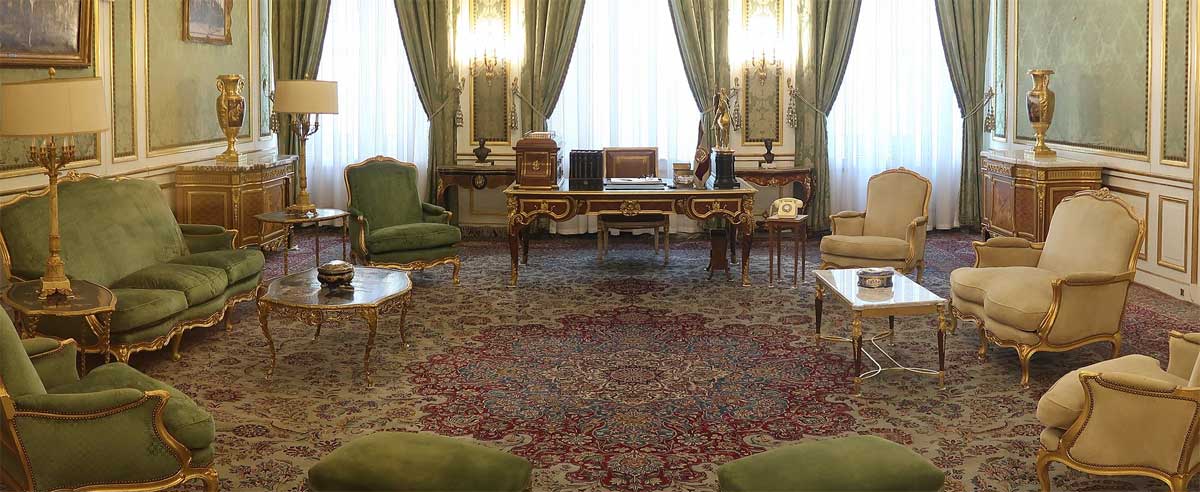
In modern Persian poetry, there are also significant poems about Arash the Archer. Contemporary Persian poets in our era are also writing poems about Arash the Archer. Iranian poet Siavash Kasraei and Persian poetess Turan Shahriyari have written eloquent verses about the legendary Archer Arash. Now you can read Siavash Kasraei’s poem about Arash the Archer, but remember that in folk tales and folklore, there are mentions of great heroes who accomplish extraordinary feats. The lands of Sindh, Balochistan, Saraiki, Waziristan, Punjab, Pashtunkhwa, Gilgit-Baltistan, and Kashmir are also filled with such folk tales and stories of extraordinary heroes, but the real heroes of history are the common people who, through perseverance, create possibilities out of impossibilities and through their hard work, shape the world as it exists today.
I place my hand on the shoulder of Manzar Naqvi and say that the revolution may have ousted Reza Shah Pahlavi and his regime, but it did not harm Iran. From the Saadabad Palace complex, we go to the shrine of Imam Musa Kazim’s son, Saleh bin Imam Musa Kazim.
Leaving the palaces and courts of tyrannical kings and entering the shrines and hospices of the oppressed was a unique experience. Outside the shrine, we saw the graves of Iran’s scientists, their companions, and household members who successfully challenged the scientific superiority of imperialism. They played a role in bringing Iran into the next era of science but lost their lives for the success of the revolution, sacrificing their lives for Iran.
